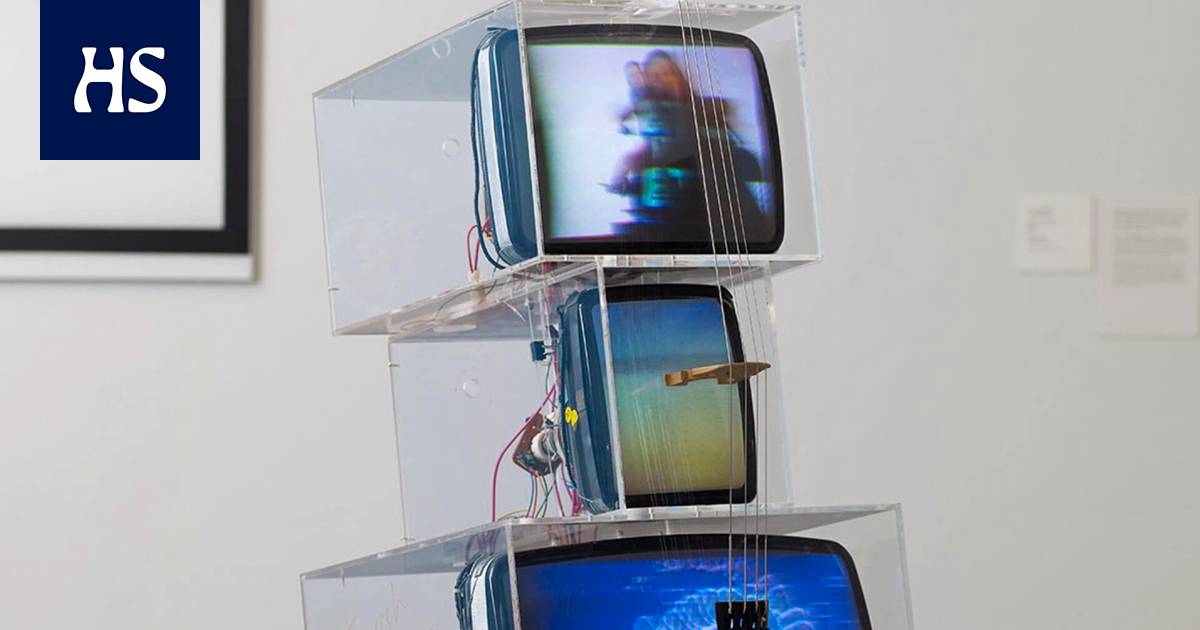Korean video artist Nam June Paik created a piece about a Finnish dream.
Nam June Paik: TV cello: Suomalainen uni, 1991, Museum of Contemporary Art Kiasma collection.
Nam June Paikin (1932–2006) in the work TV cello: The Finnish dream (1991) are three transparent Plexiglas cases, each containing a television. Cello strings are tuned to the surface of the cases stacked on top of each other: there are four tuning pegs at the end of the plexiglass neck, the pedal is located on the steps of the central television receiver, and the entire instrument rests on a short leg.
TV cello belongs to the collections of the Museum of Contemporary Art Kiasma. The museum’s curator of collections Kati Kivinen says by email that TV cello was ordered directly from the artist when the museum was founded. For the first time TV cello was exhibited in 1991 at the Ateneum, from which the Museum of Contemporary Art operated before the Kiasma building was completed.
Kivinen says TV cellon to be a colored version of Paik’s older, black-and-white work TV Cello (1971).
Nam June Paik was the father of video art. The artist from Korea studied composition in Germany, but moved to the United States, where he was a key influencer of the avant-garde movement Fluxus.
Paik handled in his art, he often uses television receivers as musical instruments. Already in 1963, in the exhibition “Exposition of Music – Electronic Television” organized at the gallery Parnass in Wuppertal, Germany, prepared television monitors were seen that resemble John Cage’s prepared pianos.
Prepared pianos shook up the performance practices of classical music and shaped the perception of music and its presentation. Paik’s television instruments also strive for the same. At the same time, they questioned the typical prejudice of the time about mass culture as entertainment that numbs thought.
The place did on the TV cello collaboration cello artist by Charlotte Moorman (1933–1991) with. Moorman was Paik’s long-term partner. For example, in a performance presented in 1969 TV Bra for Living Sculpture prejudices were torn apart at a concert where Moorman, who plays the cello, has put on a bra made from small television receivers.
TV cello: The Finnish dream -you can try to get into the tonal world of the work by watching a video found on YouTube, with which Moorman plays the black and white TV-Cello. Moorman plucks the instrument’s strings and slides the bow back and forth. If you watch the video without sound, you could imagine soft legatos, soft pizzicatos and soft melodies emerging. However, the playing recorded on the video sounds more like an industrial clatter and a low hum of an electric guitar than the familiar tone of playing a cello.
The Kuvan takana series presents the treasures of Finnish art collections.
Read more: The Kuvan takana series presents the treasures of Finnish art collections deeper than the surface
Read more: A forgotten treasure was found in the National Gallery’s warehouse a couple of years ago
Read more: The characters in Otto Mäkilä’s painting see something that we don’t
#picture #cello #father #video #art #shaped #perception #music #presentation









